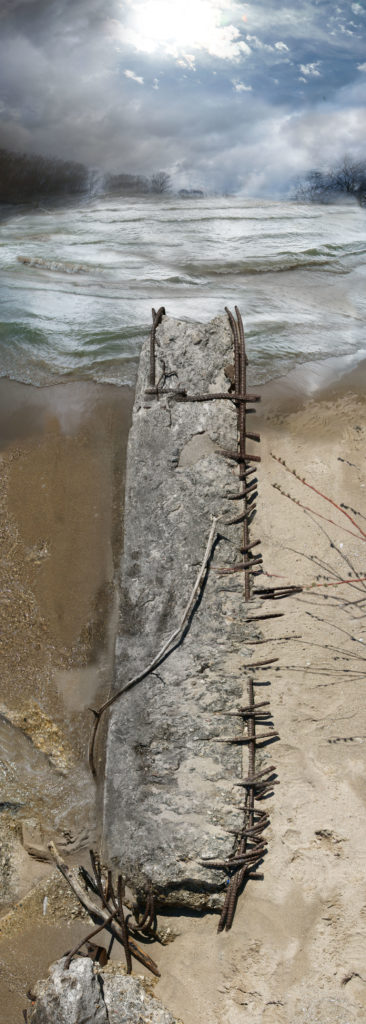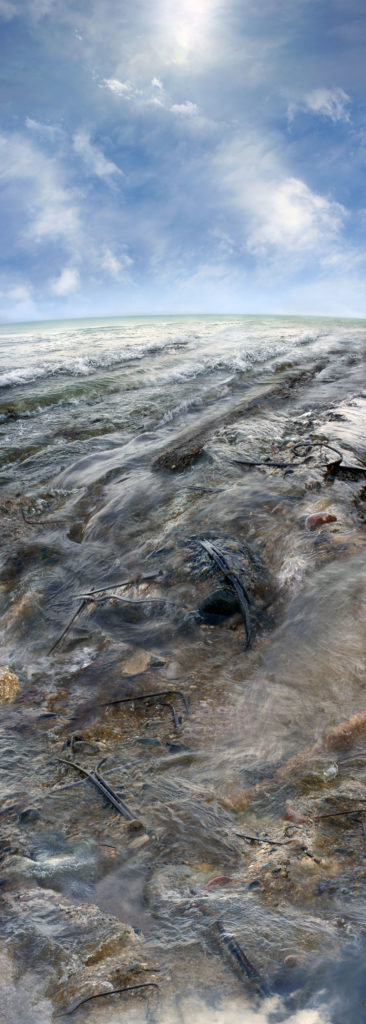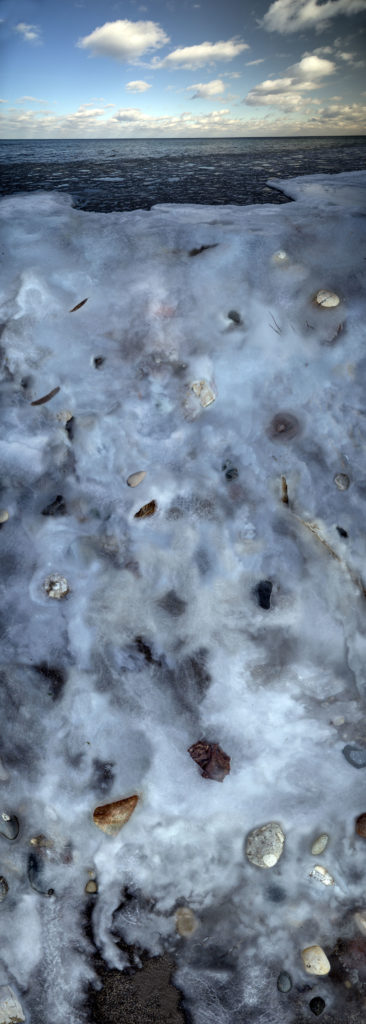The Tick
On the evening of June 20, 2012, a Wednesday, I found a tick on my nape. I was at my desk absorbed in my work when I felt a slight creeping sensation beneath my collar. My left hand rose automatically to my neck as my right hand continued correcting some long-overdue text. I brought something tiny to the lamplit paper then recognized what the weirdly flattened thing was. It was not engorged; it had not yet attached itself. As swiftly and reflexively as I had grabbed it, my pen nib came to skewer the tick on the white page. Its legs gradually ceased squirming. A translucent black fluid oozed from the pinioned insect onto the paper. It was not blood; as I said, it had not yet bitten. It was not quite like ink either. All of this happened smoothly and instinctively. The nouns tick, nape, paper, translucence, pen, ink, offered themselves just after the action, but not before it occurred to me that the dark liquid I was observing was melancholic bile.
This is what I could recall of the humours as the tick died. They are the fluids that circulate through the body, connecting the shifting moods to a cosmologically moistened circuitry. Their collective origin is the liver; their particularities arise with their circulation through various glands and organs. The sanguine person is linked in a responsive relationship by a bloodlike fluid to air, and so is expansive in both body and spirit. Cholerous yellow bile is exuded by the gall bladder, in the skint bitterness of anger. The phlegmatic humour seems to move with the sleepy coolness of water or lymph. Only black bile, the fluid of melancholy, whose source is the spleen, has no observable correlative among the various human fluids. It is not like chyle or wax or tears; black bile is purely imagined. It is a spurious fluid necessary to supplement and correct the assymmetry of the other three, and thence to connect the cosmical human body to the four worldly elements. The element of melancholy is earth.
How had this tick arrived on my person? I have a dog; a flea will occasionally cross from her body to mine, and so might have the tick. Or the tick could have fallen directly onto me from the branches of the cherry tree where my dog and I had sheltered from a bout of rain during our morning walk. If it had indeed arrived on my person that morning, the tick had spent the long day making its way from my jacket or my loose hair to the bare skin of my nape. We had been eating cherries beneath the tree as it rained, my dog the rotting ones from the ground, me the low hanging over-ripe ones that were splitting in the wet summer. I did think of Rousseau and his cherry idyll as my dog and I ate, that passage in the Confessions where a cherry orchard in full fruit served as foil for a nascent flirtation. The young Rousseau, on his ladder or his bough, I can’t remember which, had tossed down cherries for two girls to catch in their out-held skirts. The style then being décolletée, some cherries missed their marks and caught in the girls’ soft breasts. If only I were cherries, Rousseau had thought, looking down from his perch at this colourful vision. Or so he wrote. I believed the claim was the retrospective one of the middle-aged writer; it was too tidy and humorous for adolescent lust, which could not have changed much between Rousseau’s time and ours. And enjoying my idle doubt I had continued to eat the burst-open fruits, spitting pips into the wet grass, or sometimes leaving them clinging palely to their stems on the branch, these cherries were so ripe.
I lifted my pen. The tick was now a smear. Near my desk, on the little couch I had abandoned to her use, my dog napped, groaning softly from time to time with a kind of deep satisfaction, or perhaps, I sometimes suspected, only to please me with this thought. I was familiar of course with Durer’s etching of melancholia, but my image of it was vague, darker even than Durer’s own chiaroscuro, and the only true detail I could bring to mind from the famous etching was the wrinkled or ruffled appearance of the sleeping dog’s ears, as if they were the crumpled inner leaves of Batavia lettuces, so unlike my own dog’s ears, which remained vigorously upward-pointing like tulip swards, even in sleep. I was curious to look closely again at Durer’s image. I rose to search for the only book in my library I was certain would include it, a fairly recent collection of the translated writings of the mercurial art historian Aby Warburg. I had ordered this book several years before, specifically to read the great scholar’s essay on Saturn and melancholy; and so it was because of my arcane interest in the history of melancholia that I came to learn of Warburg’s library, his atlas of memory, and the astoundingly compelling mobility of his thought. It was 10:35 and outside the solstice sky was just darkening. There was the occasional liquid trill of the season’s last nightingales to deepen the evening. I heard my neighbours’ shutters close.
This is all wrong. It was not 10:35 pm, it was late morning, I was not correcting some unnamed manuscript, I was reading an essay by Emile Benveniste, my dog was not sleeping, she was whining softly near the kitchen door, calling for her deferred walk. I was taking notes as I read. The essay was the infinitely gorgeous ‘The Notion of Rhythm in its Linguistic Expression’. Each time I attempt to summarize this essay it reconfigures itself sinuously just beyond my comprehension. I feel for it something like a lover’s rapture. I say this knowing how overblown the sentiment will seem, but when in the first paragraph Benveniste tidily demolishes the conventional etymology of the word rhythm, disproving with a precision bordering on arrogance the long repeated belief that its Indo-European root is related to the natural-seeming alterations of temporality and the regular movement of the waves, at each reading my excitement is physiological and fresh. I know I am about to enter something unimaginably nuanced. He frees rhythm from nature understood as an external, environmental limit, and introduces me once again to the human abundance of form. But for Benveniste, following the atomist philosophers, form is not a limit either. Form is like a gestural passage that we can witness upon a garment in movement, a face in living expression, or in the mobile marks of a written character as they are formed by the pen. Rhythm is time, but it is time as the improvisation that moves each limited body in play with a world. Not necessarily metrical, it’s the passing shapeliness that we inhabit, and it both has a history, and is the history which our thinking has made. As I achieved the apex of excitement in my rereading of this beautiful document, attempting to grasp anew how a concept becomes quite literally a landscape (for only much later in the history of this word had rhythm come to articulate and even make perceivable the repeating or cycling patterns we attribute now to nature), I had felt the tick on my neck.
Now I wonder—had the tick begun to write with its bilious ink? What word was about to be spelled out blindly on the back of my neck? A tick is blind; it is also deaf and without even a sense of smell. I had read once that its only sensation is for heat. Dormant on some random foliage, where it exists only to await the sense trigger that we animals are, it drops towards the precise temperature of mammalian blood and nothing else. It lives and perceives only for the world our warmth constitutes. Like a melancholic fixing on some abstruse and frail detail to worry it slowly to a wound, once on the host’s body, the tick roams towards the barest, most tender and heated site. I had thought then about the inchoate pleasure of the arrival I had prevented, the punctum, but now I think about the phantom word I had forestalled, the unculminated nape marks of the spurious black bile.
In Durer’s Melencolia I a winged female with loose hair wreathed in small leafed vegetation sits on a low step, the weight of her leaning head braced by a clenched hand in the clichéd pose of thinking. Her elbow rests on her knee. The detailed folds of her full skirt suggest a slightly stiff fabric, perhaps linen, and where the garment falls over her seat or bench, the fine row of hem stitching is just visible as a faint relief where it slightly puckers the textile. The light is coming from her lower left side, from a source just outside the picture frame, and it reveals, resting against her hip, a chatelaine, the traditional belt worn at a woman’s waist to which she would attach her household keys and purse. Melencolia’s heavy skeleton keys are numerous in the image, and below them, at the place where her feet are hidden by the crumpled folds of the gown, is a fabric purse. Its crimped-shut openings are secured by three round buttons wrapped round with dangling ribbons or drawstrings. Melencolia glances upwards towards the right and her brow is troubled. Many scholars have discussed the meanings of the tools and objects that surround her—the sphere, the hourglass, Saturn’s magic square, the scales and ruler and hammer, the long serrated knife. They especially ruminate over the large geometrical mass to her right, behind which a ladder rises diagonally, bisecting the picture plane. The comet-like light in the sky is mentioned, the rainbow, and the gargoylish wisp of cloud that holds aloft the titular word. But I am unaware of any discussion or even notice of the tightly crimped folds of melancholia’s purse. It’s an accessory detail. Yet in this composition each component carries equivalent semantic weight; the ribs of the sleeping dog are no less meaningful than the fine stream of sand in the hourglass, or the flames in the distant brazier, or the rooftops of the far-off village seen through the rungs of the ladder.
My interest in humoural theory had to do with my recent move to a small agricultural hamlet. The windows of my cottage face east and west; I watch the sun rise and set over large fields, and often the farmers are out working in their huge modern tractors with the glassed-in cabs already as the day begins, or after it ends and I am in bed. I began to see that the landscape, like the sky, is at every point, at every minute, extremely active, never repeating. Insecticide is being sprayed, wheat is being threshed at midnight, one morning a white powder would appear dusted over the ploughed up rape field, in early autumn the wheat will be planted, frost on ploughed earth would change the character of the light. The huge, yellow, cylindrical straw bales would be irregularly scattered as far as the horizon, like some giantesque game of chance or lesson in constructive geometry. And the place of the sunrise will slowly swing from the dark massy smudge that was the oak forest in the mid-distance, to, in midwinter, the rusted roof of the agricultural shelter beside which grew the ancient and apparently abandoned cherry tree. When I walked my dog late mornings I would discover fruits I had never known of, on trees bordering the fields. Pêche de vigne that shot pungent scarlet juices as my teeth punctured the tough brownish skin; and tough medlars, which used to be called openarse, since their calyx end resembled a dark rectum, and which made for marmalade before the importation of citrus fruit to this continent; and the rowan fruit, which become sweet only once rotten, and which served the poorer people of this region for a kind of rough tannic wine. And the more familiar trees too, the walnuts and sweet chestnuts, and the wild rosehips, so that always I came home from our walks with my pockets stuffed, if I had not thought to bring along a little sack for my findings. And these fields and hedges that I walked among were the same ones I saw depicted in the paintings I would look at in the regional Beaux-Arts museum. Poussin’s fields and riverbanks were precisely the ones I lived among, and the same for the unknown minor painters whose works are so interestingly copious in the provincial museums. When some passing grippe overtook me, I felt it settle into my cells like a fluent weather, the same weather that changed the colour of the leaves of the cherry tree. And in the nearby little churches and funeral chapels, primitive frescoes depicted scenes from the book of Revelation, or the woman’s temptation at the fruit tree, and the rudimentary yet subtle pigments were made from the local river-clays and oxides. Landscape was the same as painting, and it was the same as time, and health, and the economy. I say the same, but what I mean is that all these things mesh to form a fabric, which, like a worn garment, moves, shifts, arranges itself in figures recalling the idiosyncracy and emotion of the animal face. The notion of a rhythmic cyclicity is an invented concept we deploy from a great distance to placate the intensity and vulnerability of time. I felt that here, ironically, given my foreignness and my oddity for my neighbours—for here I was, female, solitary, middle-aged, with prodigious accent, ancient automobile, expensive computer, and spoiled mongrel, writing at the edge of a field—here, where every distance was specific in its replete variation, and nothing ever truly repeated, my own melancholy had a home.
Benveniste, in his last seven years, suffered a stroke, then the loss of his speech, but not his presence of mind. He was often visited at the hospital in Créteil in the years between 1969 and his death by Julia Kristeva, who had been one of his students and younger colleagues. Kristeva describes his still joyous expression on receiving his guests; his face and his laboured ability to gesture with his fine hands (although not truly to write) were his only means of communication. She recalls specifically one afternoon shortly before his death. His sister had contacted her with the message that Benveniste requested her visit. He beckoned her to approach him more closely, and with a mischievous yet shy smile he began to shakily trace, using his index finger, some letters on the blouse covering her chest. She was flustered and confused and drew away with some embarrassment, upon which he leaned forward and attempted a second time to spell out his undecipherable message. She then hastily offered him a Bic pen and paper, and with some difficulty he traced out four Greek letters—THEO, in majuscule. This was Benveniste’s last written word. What did god mean to the great linguist and mentor in his speechless final years, written enigmatically upon his female student’s blouse? Was this THEO the meeting between unspoken, interior languages and subjectivity itself, between the subject’s experienced ‘I’ and the ‘you’ who necessarily received the affective enunciation, between the general capacity towards such an utterance, and the experience of the body’s limit, as she later thought? How can we imagine the involuntary seven-year silence of the linguist other than as a profoundly etched chiaroscuro? Was the writing of any word a permanent revolt against structural determination, a plunge into the infinite generosity of signification, the conversion of that generosity to an iconic name? What was her blouse like?
Canadian poet Lisa Robertson has published many books, most recently 3 Summers from Coach House, and the essay collection Nilling, from BookThug (both Toronto). Recent texts written for artists have been included in the catalogues The Blue One Comes in Black (Liz Magor, Triangle and Mousse) and Strange (Karl Larsson, Mousse). With Matthew Stadler she edited and annotated Revolution: A Reader (Paraguay), a 1,200-page performative record of living in the present. She lives in France.
An earlier version of this text was published in 2012 by Vancouver artist Tiziana La Melia, in a hand-distributed zine.


